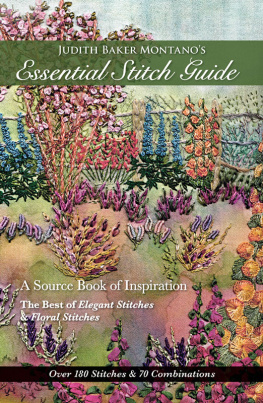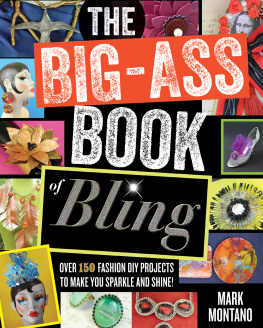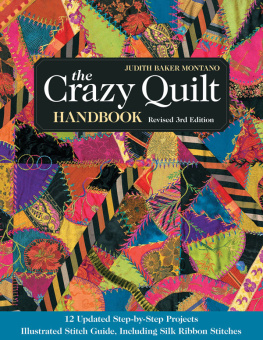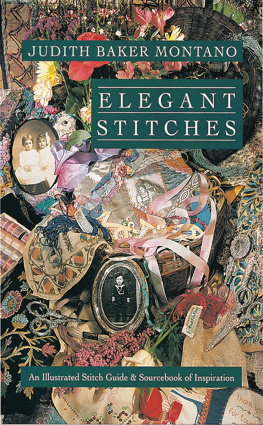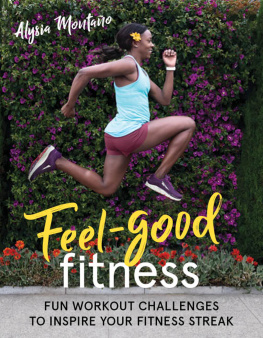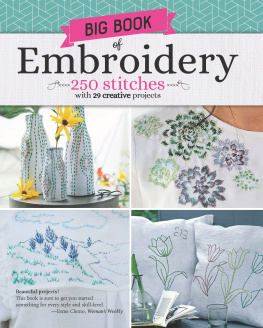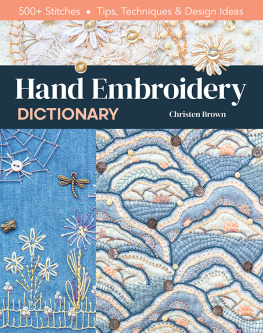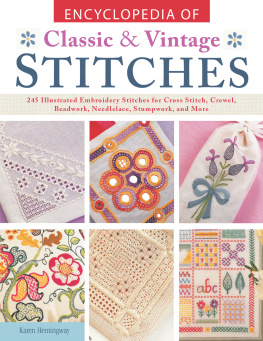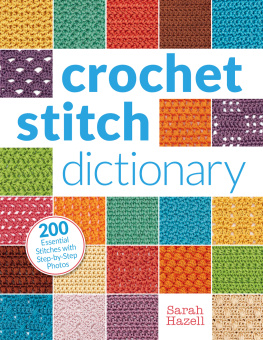Publisher: Amy Marson
Creative Director: Gailen Runge
Art Director/Cover Designer: Kristy Zacharias
Editor: Lynn Koolish
Technical Editor: Helen Frost
Book Design: Page+Pixel
Production Coordinator: Zinnia Heinzmann
Production Editor: Joanna Burgarino
Illustrators: Judith Baker Montano, Michaela Carr, Ginny Coull, Mary Flynn, Tim Manibusan, Alan McKorkle, Kirstie L. Pettersen, and Richard Sheppard
Photography by Judith Baker Montano, unless otherwise noted
Published by C&T Publishing, Inc., P.O. Box 1456, Lafayette, CA 94549
DEDICATION
This book is dedicated to my wonderful students and readers. Thank you for your support and friendship.

Embroidery. The word conjures up so many memories for me: my grandmother finishing up yet another set of tea towels, one for each day of the week; the gift of a chain-stitch horse head, made by my daughter in her seventh grade home economics class; the silk ribbon flowers on my wedding dress still hanging in the closet; the silver crane worked in silk by a Japanese student, shyly handed to me in Tokyo, Japan; happily embroidering flowers on denim overalls for my granddaughter Kelse seventeen years ago and now for my youngest granddaughter, Paloma. All those wonderful memories are woven around embroidery.
Thanks to the embroidery and quilting world, I have a wonderful career as a teacher, designer, and fiber artist. It has taken me around the world and opened so many doors. Ive found that women and men from all walks of life enjoy needlework. Ive seen students around the world come together to enjoy the common denominator of cloth, needle, and thread. Ive taught classes where more than ten different languages were spoken and yet everyone understood the language of needlework. Whether you use embroidery to enhance the beauty of a fabric, to create an original work of art, or to simply relax from a busy work schedule, it is a technique that is here to stayone that brings great satisfaction and pleasure.
I could have used a good stitch book in the beginning because I really struggled with the stitches. I used the Coats & Clark pamphlet 100 Embroidery Stitches to learn the basic stitches, but because I am dyslexic it was very difficult to follow the instructions. Thats why years later I wrote the embroidery stitch books Elegant Stitches and Floral Stitches. Now I am combining them into one concise stitch dictionary. It is a basic reference book of categorized stitches that you can easily work in thread, yarn, or ribbon. I have included photographs, clear instructions, and precise diagrams.
You will also find:
Embroidery basics including needles, fabrics, and supplies
Advice for left-handed stitchers
Crazy-quilt stitch combinations
Free-form embroidery stitches

Embroidery is a very rewarding art. It will give you years of enjoyment, but like any hobby or craft, it takes practice and patience. Start with the proper tools and materials and get to know their uses.
FABRICS
Many fabric types will provide interesting and varied backgrounds that can enhance the needlework and not overshadow it. Add an extra 2 to the fabric measurement to aid in the handling and stretching of the fabric prior to stitching. Always test to make sure the base is sturdy enough to act as a background for your design.

ASK YOURSELF THESE QUESTIONS WHEN CHOOSING A FABRIC:
Is the fabric appropriate for the subject matter?
How much wear and tear will it receive?
Will the threads, yarn, or ribbon work up properly on the fabric selected?


OVERLAYS
Use sheer fabrics as overlays to create interesting and unusual effects for the background. By cutting or burning the pieces into unusual shapes, you can create a feeling of depth and shadow. By layering several sheer fabrics and letting the cut or burned shapes overlap in places, you can create light and dark areas for visual interest. A painted background may be muted with sheer overlays to create a hazy effect. I use this method to create underwater scenes.
Always have a good variety of sheer fabrics on hand. Look for organza, netting, tulle, and batiste. Many of these fabrics now come in a wrinkled state and some have glitter.
NEEDLES


THREADS
The choice of thread is always governed by your choice of fabric and the project in mind. Experiment with different threads and yarns to find what works best with various types of fabrics.

TECHNIQUES
Embroidery
Think of the stitches youve learned over the years and choose those that will best support your floral design. Remember that your fabric is like a painters canvas, and you are the artist. Your threads and yarn are your paints. Use a selection of threads and yarns with a variety of widths and textures.

Silk-Ribbon Embroidery
Silk-ribbon embroidery uses traditional embroidery stitches that add dimension and texture. It is a marvelous medium for floral designs. The traditional width is 4mm, and you must use either a chenille or a tapestry needle to execute the stitches. Silk ribbon is wonderful to mix with other embroidery techniques.

The secret to good ribbon embroidery is to keep the stitches loose but controlled. With some stitches it is very important to keep the ribbon flat. Silk-ribbon embroidery is dimensional and fast. Here are a few tips to make your stitching easy and successful.
Threading the Ribbon: Remember, silk ribbon is delicate and will fray on the edges. Use a short length (1216) and a needle with a larger eye.
Needle Eye Lock: Thread the ribbon through the eye of the needle. Pierce one end of the ribbon (directly in the center and from the end) with the point of the needle. Pull the long end of the ribbon and lock it into the eye of the needle.

Soft Knot: To make the needle eye lock, grasp the end of the ribbon and then form a circle with the end of the ribbon and the point of the needle (A). Pierce the bottom end of the ribbon with a short running stitch (B). Pull the needle and ribbon through the running stitch to form a soft knot.
Next page
